Review and images by Alopias superciliosus; edited by bmathison1972
I appreciate Shark Week on the Animal Toy Blog far more than I do the actual shark week programming on Discovery because the reviews on the Blog are more in line with what Shark Week should be and once was: an educational look at a fascinating group of animals, as opposed to over-dramatized, fear-mongering pseudo-science. I wanted to end this year’s shark week with a group of shark toys that fully encapsulate the diversity of sharks and highlight obscure species that seldom get the recognition they deserve.
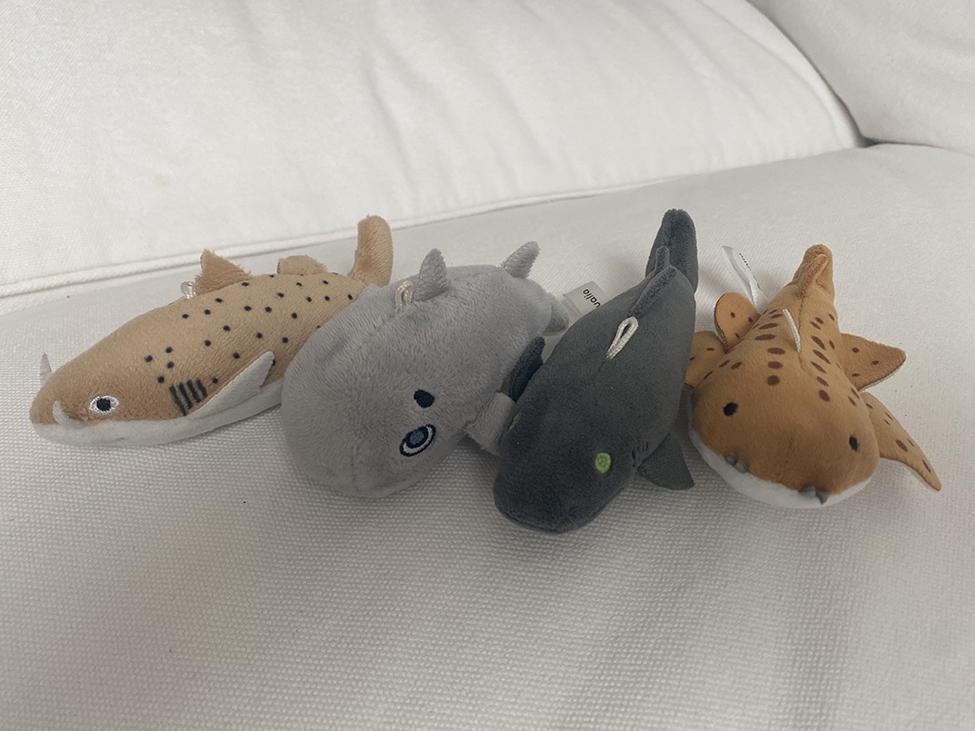
Qualia is a Japanese company that makes an insanely wide assortment of gashapon toys, often in the form of keychains. Amongst the huge selection of licensed character gashapon toys, Qualia has also made four series of plush shark keychains. While stylized, these plush keychains are well made and are all meant to depict distinct species of sharks. The series has pulled some exceptionally obscure species to be represented, so much so that four species of sharks have ONLY ever been depicted in a figure/toy format as a Qualia plush keychain! As a synoptic collector of sharks who needs every species of shark ever produced represented in my collection, picking up these four unique sharks was a must. In this review, I’ll go through each of these unique species (the word “unique” here means a species’ only depiction), share some fun facts about these obscure sharks, suggest why a Japanese company like Qualia likely chose each species, and see how the plushes stack up as representations for the species.
As a general disclaimer- these are inexpensive plush gashapon plushes, only about 4-5 inches (10-13 cm) long. They are inherently stylized; holding them to the same standards of accuracy as companies that make plastic shark models would be a wasted exercise. I’ll commend the plushes where they get details right and critique them for major flaws. Oh, and as a disclaimer on gills so I don’t need to discuss that four times- the gill situation is all wrong. Each species here should have five gills, but they are instead depicted with four, three, or zero slits.
Series 1 of the Qualia sharks didn’t have any unique species, but Series 2 delivered quite possibly my favorite of the unique Qualia species, a plush Mandarin Dogfish.
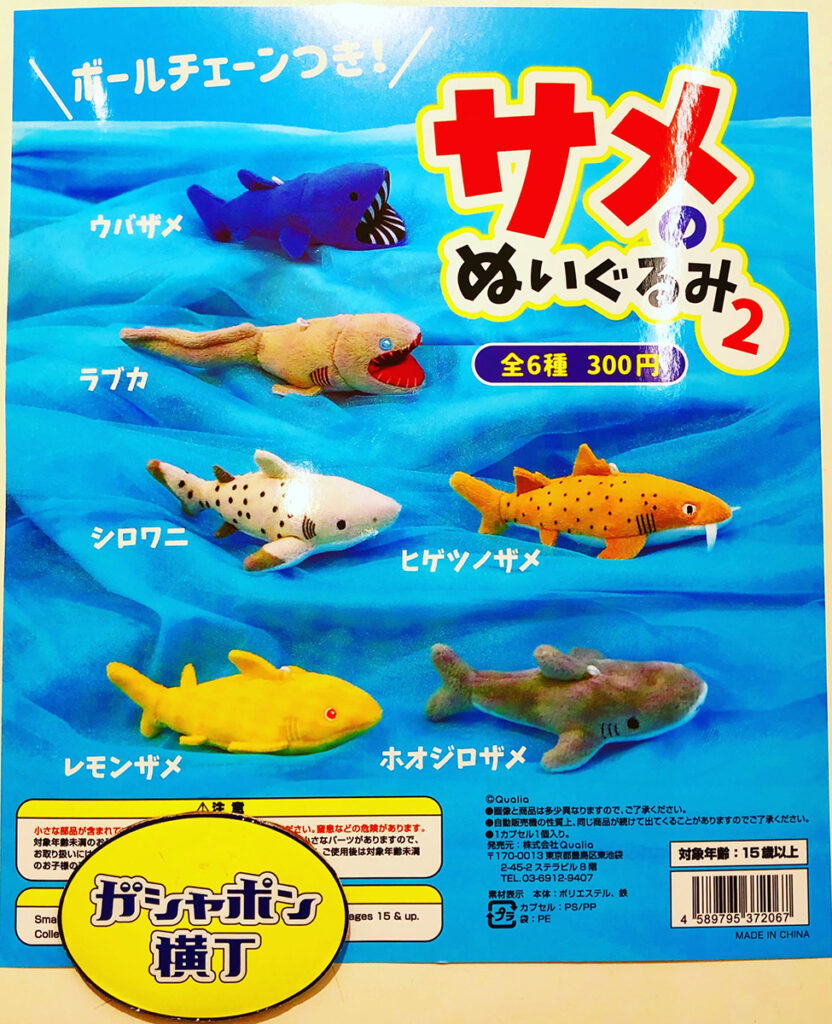
Right row, top to bottom: Mandarin Dogfish, Great White
The Mandarin Dogfish (Cirrhigaleus barbifer) is a little-known species of deep-sea dogfish in the Squalidae family. The shark was first discovered in Japanese waters, and is most frequently encountered in Japanese waters, with only a handful of reports from elsewhere from Taiwan and Indonesia. The Mandarin Dogfish is unique for its exceptionally long barbels, sensory appendages which likely aid the shark in locating prey. Only five Mandarin Dogfish are present in captivity, spread across four aquariums in Japan. They apparently do quite well in captivity, despite being accustomed to depths of 140-650 meters; the Mandarin Dogfish at the Toba Aquarium has been there since 1990 and was still alive as of a news article in 2021!
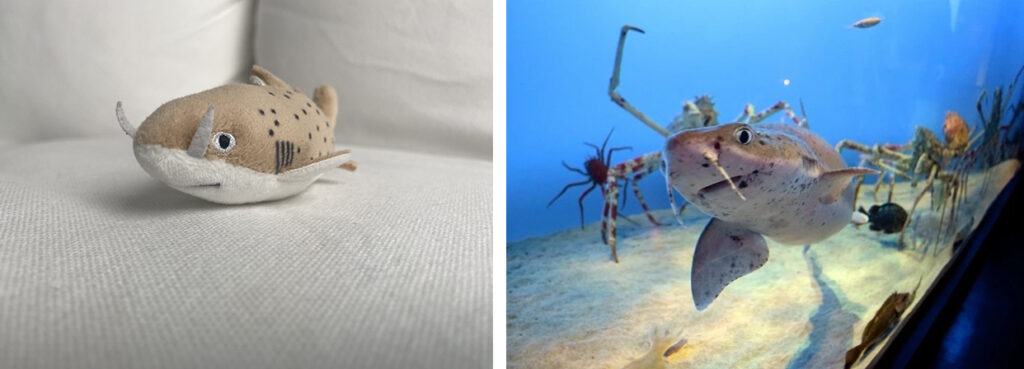
The plush gives the shark an appropriately shaped streamlined body and the correct number of fins. The spines in front of the dorsal fins are represented by a notched point in the fin fabric. The plush’s dorsal side is in tan with black speckles throughout. This is an accurate color scheme, and one that closely matches the individual at the Toba aquarium (Mandarin Dogfish vary in color from tan/brown to a dark grey, and with or without dark speckling). The species’ distinctive barbels are present as two white strips of fabric extending from the nose. While the barbels of the actual shark always hang below the animal, how they are stitched in the plush (at least in my copy) forces them into an unnatural upwards or perpendicular orientation.
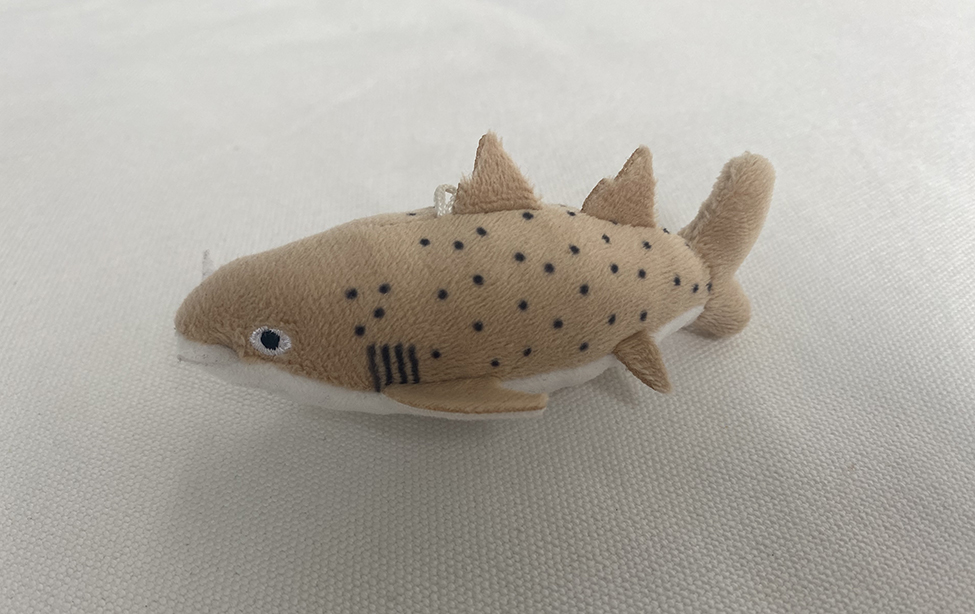
Besides the poorly positioned barbels, this is a delightful depiction of an equally delightful shark! I have always had a soft-spot for Mandarin Dogfish; they’re big eyes and goofy barbel “mustaches” make them very endearing. I’m happy a recognizable depiction of this shark exists!
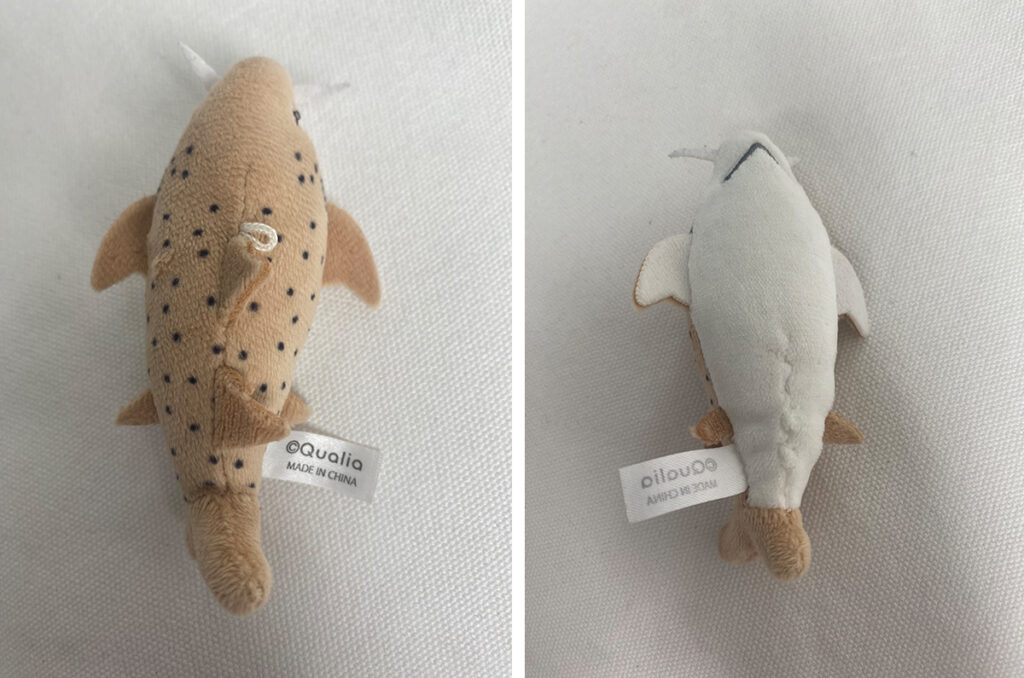
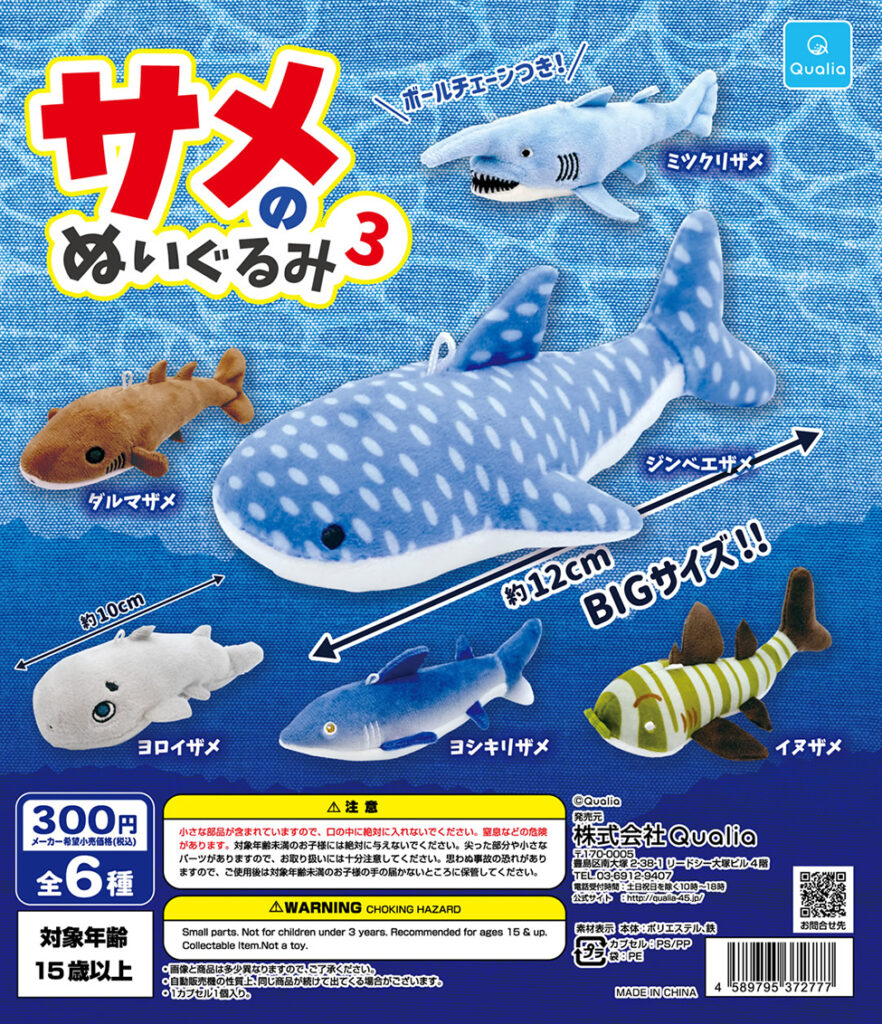
Series 3 brought another unique shark species, the Kitefin Shark, (Dalatias licha)! The Kitefin Shark is a close relative of the Cookiecutter Shark (who, interestingly, also appeared as a plush in Series 3). The Kitefin Shark inhabits deep ocean waters between 200 – 600 meters. At up to 6 feet (1.8 m) long, the Kitefin Shark is the largest known animal to exhibit bioluminescence, containing photophores on its belly pointed downwards. The shark’s bioluminescence likely helps in stealth as a form of counter-illumination, although some scientists have also posited it might use its illuminated belly to light up the sea floor to search for prey. The Kitefin Shark possesses an enormously strong bite for its size and large triangular cutting teeth on its lower jaw, features it uses both to catch prey (bony fish, smaller sharks, cephalopods, crustaceans, and siphonophores), as well as excise chunks of flesh from large sharks and whales like its relative, the Cookiecutter Shark. The shark is targeted for its meat and liver oil in Japan, Portugal, and South Africa.
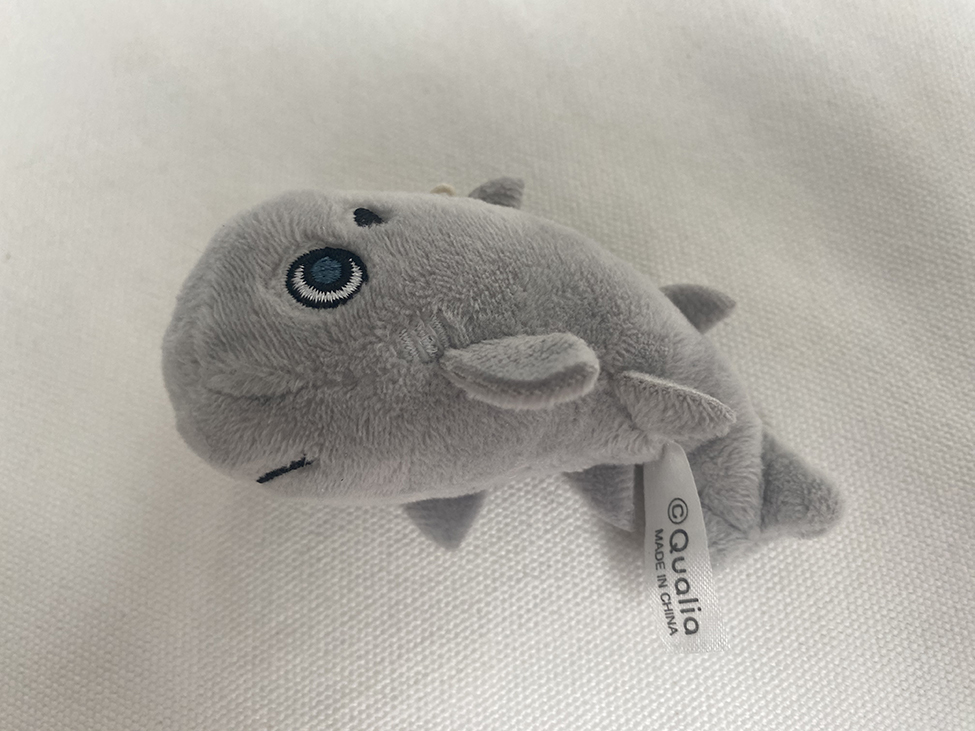
The Kitefin Shark plush itself might be my least favorite of the bunch, as I don’t think it does a good job of capturing the look of the species (or conveying that it is a shark generally; you’d be excused if the shape and color of the plush made you think it was meant to be a whale at first glance). It is definitely the most stylized of the bunch, being given a massive broad nose and head and a very small body. While Kitefin Sharks do have a short, rounded snout, their body overall is very thin and elongated, something this plush does not capture. The plush does contain the correct amount of fins, and the pectoral fins are appropriately shaped, but the distinct rounded dorsal fins are not present, instead replaced by “typical” triangular fins. The addition of the spiracle behind the eye is a good touch, however; the spiracle is indeed conspicuous on this species. The body is entirely done in a light gray fabric, which is an odd choice- the animal is a dark purply-brown in color (maybe this was done to offer more color variety in Series 3, with the Cookiecutter Shark already in a dark brown?).
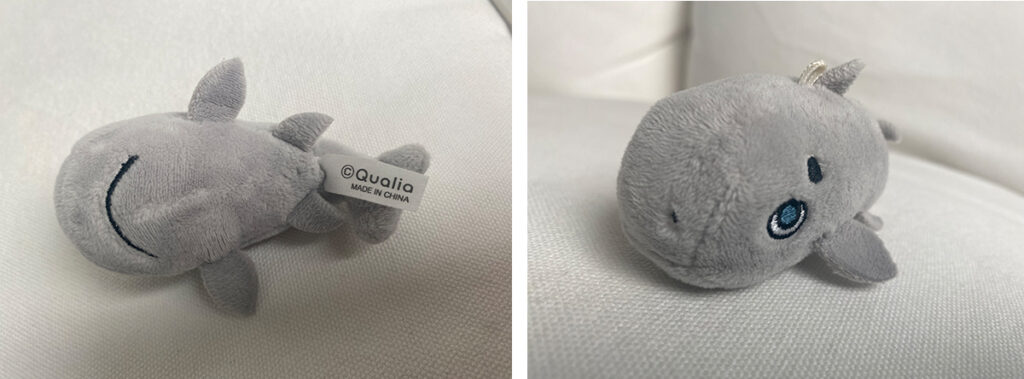
Series 4 delivered two unique sharks, the Japanese Angelshark and the Roughskin Dogfish. As far as I am aware, Series 4 is still available at gashapon machines in Japan and available online through websites like Aliexpress.
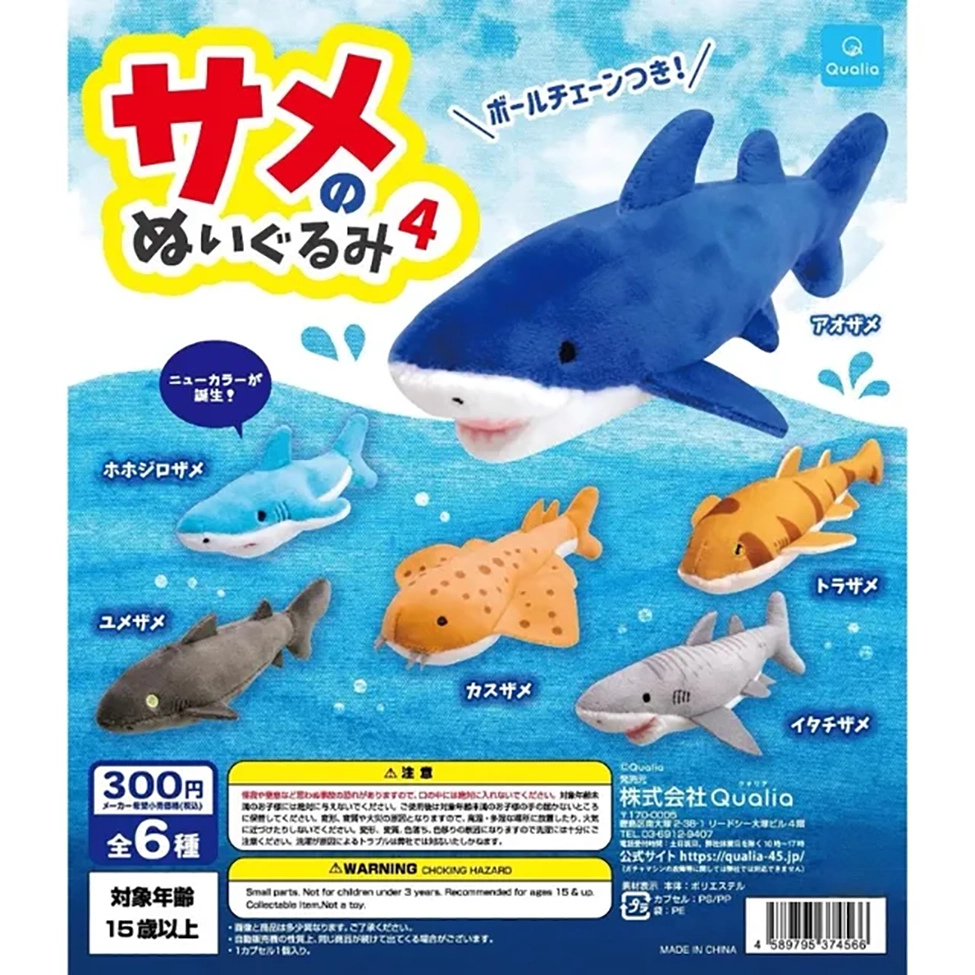
The Japanese Angelshark (Squatina japonica) is a species of angelshark found in the Sea of Japan, Yellow Sea, and East China Sea. Like other angelsharks, the Japanese Angelshark is narrowbodied with large pectoral and pelvic fins. During the day, Japanese Angelsharks bury themselves in sand, lying motionless until unlucky prey ventures close to its mouth. Like in other angelsharks, the speed in which the shark’s strong muscles open its wide mouth creates a powerful suction force that sucks the prey into its mouth rapidly. At night, the shark becomes a more active predator, having been observed free-swimming to catch fish, cephalopods, and crustaceans. Like other species of angelsharks, the Japanese Angelshark is highly threatened by being caught as bycatch in bottom-trawling, given their demersal nature. Bottom-trawling in the waters of China, South Korea, and Japan has increased dramatically over the last few decades, contributing to an estimated 80% decrease in the Japanese Angelshark population since the 1950s. The species is unfortunately listed as Critically Endangered.
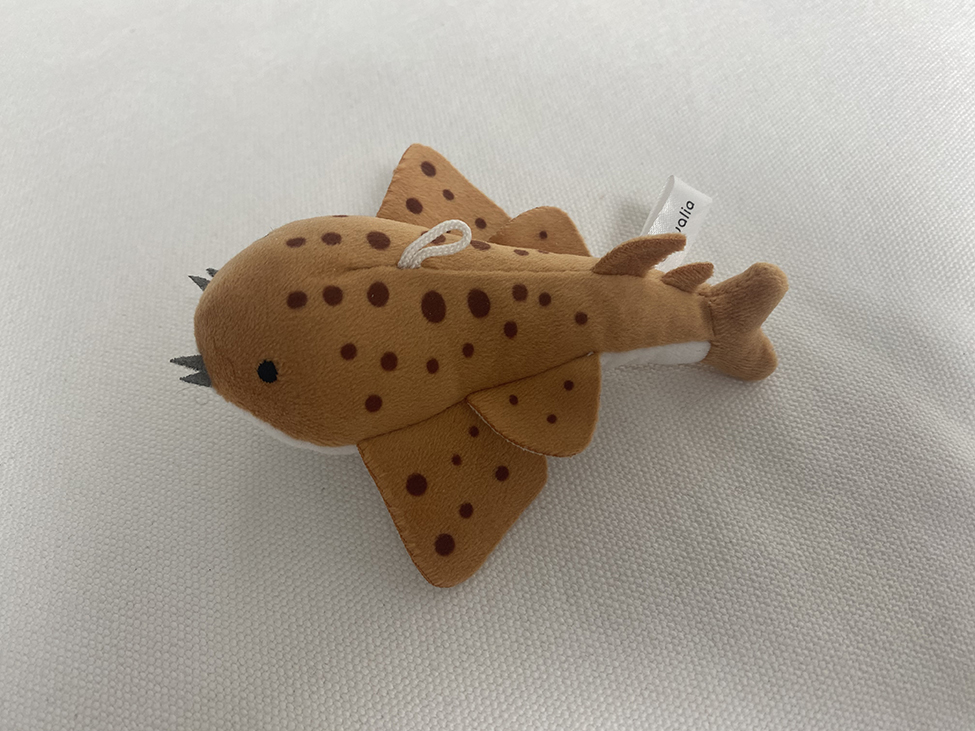
The plush does a good job of capturing the body shape of an angelshark, with appropriately large and flat pectoral and pelvic fins extending from the body. The origins of the pectoral fins could’ve started a bit higher up (closer to the head) but that is a minor nitpick. The shark has both its dorsal fins correctly placed on the tail (behind the pelvic fins) and appropriately lacks an anal fin.The shark’s two-pronged nasal barbels are included in the form of two-pointed gray spikes on the animals face; a nice detail to have included! The plush has a white underbelly and a dark orange back, an appropriate color scheme. The intricate network of spots of varying shapes and colors that cover the entire back of the Japanese Angelshark have been simplified to a few rows of brown dots. While not as detailed as the real animal, for the stylized nature of these plushes, I think the spotting does a good job of conveying the animal’s patterning without being excessively and impractically realistic.
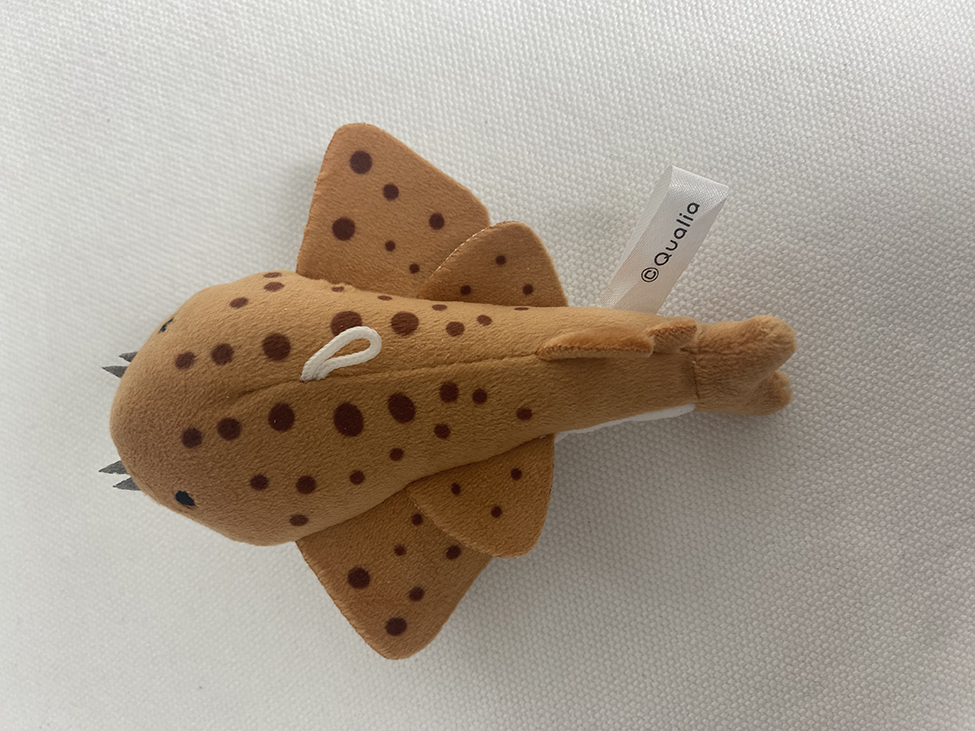
I really enjoy this plush- it’s a great depiction of an angelshark in plush form, and the only one I’m aware of! The fact that it is specifically meant to be a different species of angelshark than Squatina squatina is also very much welcome!
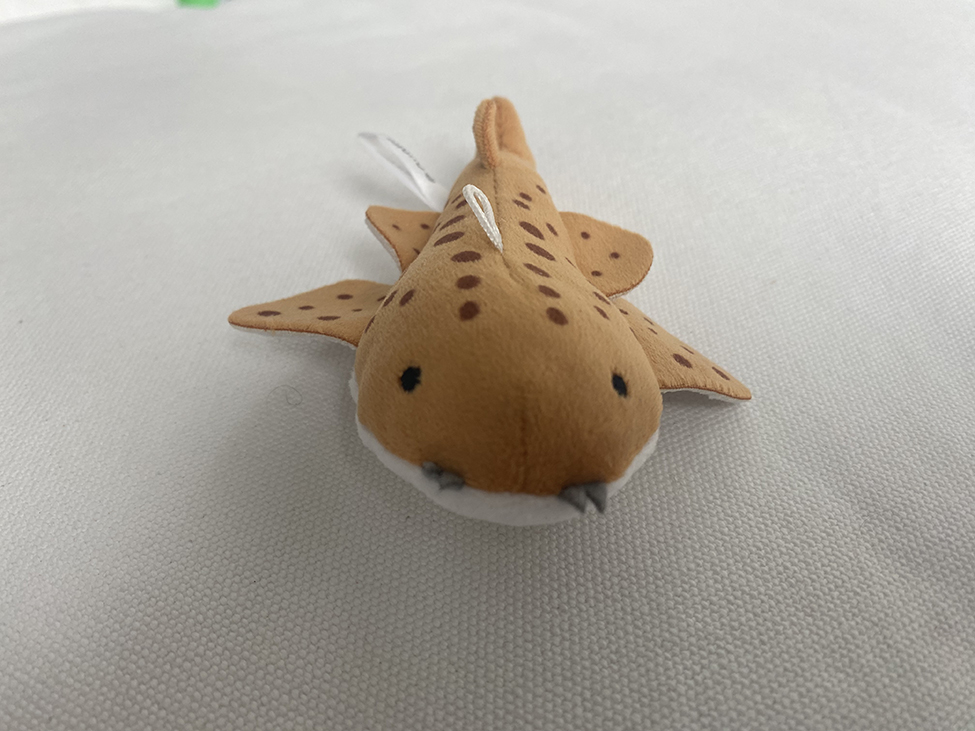
The Roughskin Dogfish (Centroscymnus owstonii) plush by Qualia joins a very small group of figures depicting sleeper sharks (Family Somniosidae). The only other sleeper shark that has ever been depicted in figure/toy form is the Greenland Shark, and only in two models (one by Larami and the other by Neko Works). Compared to its cousin the Greenland Shark, which can attain lengths of 21 ft (6.4 m) and weigh over 2,200 lbs (1,000 kg), the Roughskin Dogfish is much more diminutive in size, attaining a max length of 5 ft (1.48 m) and max weight of 47 lbs (21.3 kg). The Roughskin Dogfish is an important predator of the mesopelagic and bathypelagic, inhabiting depths between 750 – 2050 meters. Roughskin Dogfish stomach contents show they predominantly feed on blue grenadiers. The Roughskin Dogfish has been found globally. In Japan, this shark is caught for its meat and liver oil. The Japanese name, “yumesame”, directly translates to “dream shark”, in reference to the shark’s ability to close its “eyelids”. This ability is likely to protect its eyes while feeding.
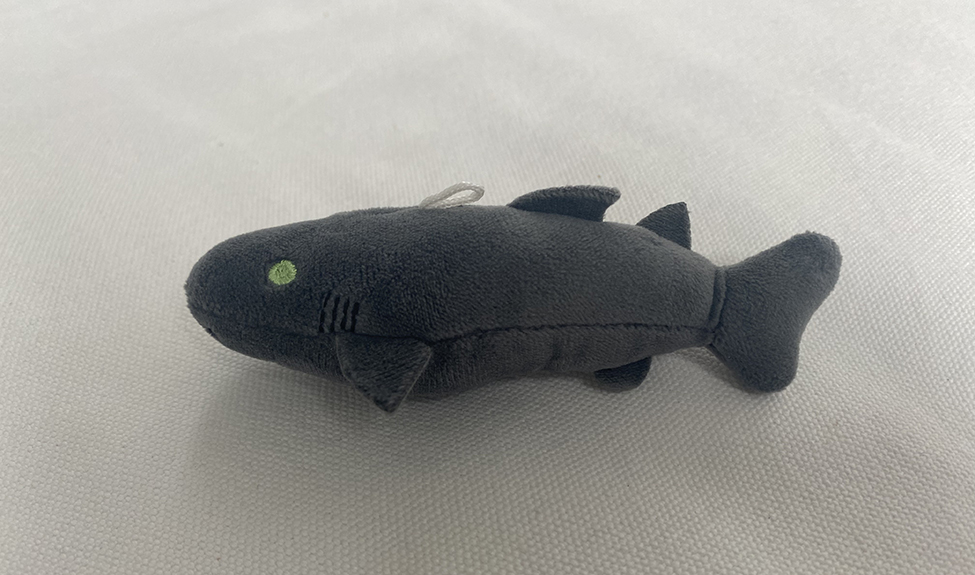
The plush is appropriately torpedo shaped (very similar in proportions to the Mandarin Dogfish plush) and almost has all the correct fins (instead of depicting two pelvic fins, the figure only has one central (anal?) fin). The “dream shark’s” distinctive reflective eye is depicted in a shiny pale green thread. This does a good job of depicting the shark’s striking eye, although I would have preferred a slightly bluer thread be used (the eyes are usually more turquoise in color than fully green). The body is done entirely in a dark gray fabric. This is an appropriate enough color, although a black or dark brown would have been more accurate.

I really love this plush, I think it does an incredible job capturing the essence of the Roughskin Dogfish! I also think it does a really good job at capturing the look of a whole host of deep sea dogfish/sleeper sharks; many species follow the same overall look; dark skin, bright green-blue eyes, streamlined, thin body. In fact, I almost feel this figure is a better version of a Kitefin Shark than the Kitefin Shark plush itself! These obscure sharks almost never get depicted in toy/figure form, so it’s great to see one of these deep sea oddities done so well. Also, this figure being a sleeper shark is laudable in general; we get far too few of these remarkable sharks in toy/figure form! We are long overdo for a well-done modern model of a Greenland Shark, Pacific Sleeper Shark, or Southern Sleeper Shark!
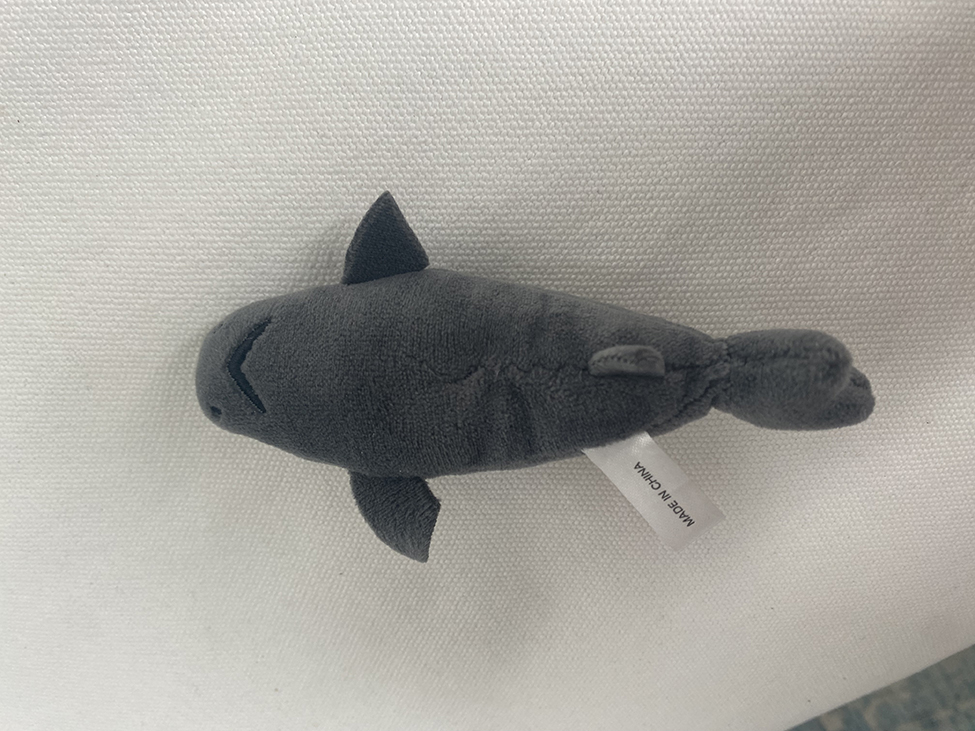
Overall, I’m so glad that each of these obscure species of sharks were chosen to be made by Qualia! There is something so charming about a company making, say, a Mandarin Dogfish toy before a Whale Shark, or a Kitefin Shark toy before a Tiger Shark! While they stand out a little from the rest of my plastic model collection, to have representation from these additional species is worth it. I would highly recommend them- as I said above, Series 4, which also contains a Cloudy Catshark, Tiger Shark, Shortfin Mako, and Great White, is still available and easy to come across. I will be eagerly awaiting Series 5 to see what unique species Qualia has chosen this time!
Disclaimer: links to Ebay and Amazon on the AnimalToyBlog are affiliate links, so we make a small commission if you use them. Thanks for supporting us!




I don’t typically give plush figures 5 stars (I just am not into them at all) but this was an exception for the species they represent :-).